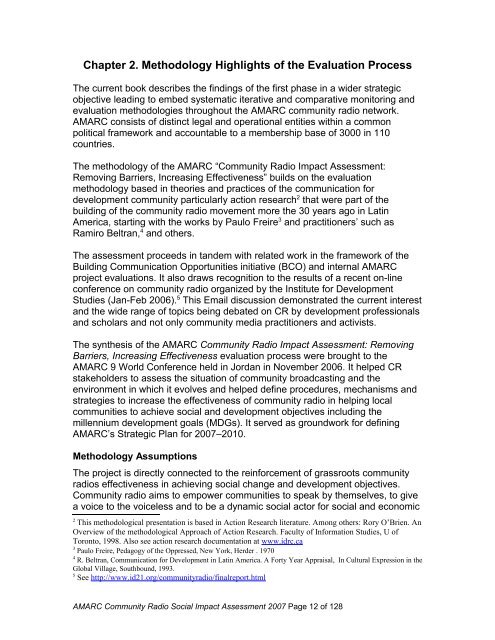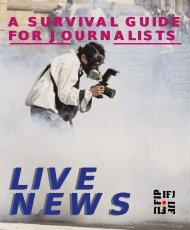Chapter 2. Methodology Highlights of the Evaluation ProcessThe current book describes the findings of the first phase in a wider strategicobjective leading to embed systematic iterative and comparative monitoring andevaluation methodologies throughout the AMARC community radio network.AMARC consists of distinct legal and operational entities within a commonpolitical framework and accountable to a membership base of 3000 in 110countries.The methodology of the AMARC “Community Radio Impact Assessment:<strong>Removing</strong> <strong>Barriers</strong>, <strong>Increasing</strong> <strong>Effectiveness</strong>” builds on the evaluationmethodology based in theories and practices of the communication fordevelopment community particularly action research 2 that were part of thebuilding of the community radio movement more the 30 years ago in LatinAmerica, starting with the works by Paulo Freire 3 and practitioners’ such asRamiro Beltran, 4 and others.The assessment proceeds in tandem with related work in the framework of theBuilding Communication Opportunities initiative (BCO) and internal AMARCproject evaluations. It also draws recognition to the results of a recent on-lineconference on community radio organized by the Institute for DevelopmentStudies (Jan-Feb 2006). 5 This Email discussion demonstrated the current interestand the wide range of topics being debated on CR by development professionalsand scholars and not only community media practitioners and activists.The synthesis of the AMARC Community Radio Impact Assessment: <strong>Removing</strong><strong>Barriers</strong>, <strong>Increasing</strong> <strong>Effectiveness</strong> evaluation process were brought to theAMARC 9 World Conference held in Jordan in November 2006. It helped CRstakeholders to assess the situation of community broadcasting and theenvironment in which it evolves and helped define procedures, mechanisms andstrategies to increase the effectiveness of community radio in helping localcommunities to achieve social and development objectives including themillennium development goals (MDGs). It served as groundwork for definingAMARC’s Strategic Plan for 2007–2010.Methodology AssumptionsThe project is directly connected to the reinforcement of grassroots communityradios effectiveness in achieving social change and development objectives.Community radio aims to empower communities to speak by themselves, to givea voice to the voiceless and to be a dynamic social actor for social and economic2This methodological presentation is based in Action Research literature. Among others: Rory O’Brien. AnOverview of the methodological Approach of Action Research. Faculty of Information Studies, U ofToronto, 1998. Also see action research documentation at www.idrc.ca3 Paulo Freire, Pedagogy of the Oppressed, New York, Herder . 19704 R. Beltran, Communication for Development in Latin America. A Forty Year Appraisal, In Cultural Expression in theGlobal Village, Southbound, 1993.5See http://www.id21.org/communityradio/finalreport.htmlAMARC Community Radio Social Impact Assessment 2007 Page 12 of 128
good. It did not involve a traditional AMARC institutional assessment in itself,except the evaluation of the effectiveness of its contribution to the developmentof the community radio movement. 6The review, impact assessment and evaluation of AMARC effectiveness aimed atidentifying barriers and increasing the effectiveness of community radiomovement social impact through proper planning, by grounding aconsultation/reflection process in the following principles:• Oriented to increase effectiveness in achieving MillenniumDevelopment Goals;• Recognize voicelessness and powerlessness as key dimensions ofpoverty• Ensure the full and effective participation of women;• Be participatory and inclusive of marginalized groups;• Address the contribution of CR to accountability, equity and civil rights• Reflect on the mission of AMARC and General assembly decisions;The project closely involved AMARC members in both design andimplementation. It contributed to clarify the situation in which community radioevolves and the challenges and perspectives it faces. The process will helpdevelop tools for proper assessment of community radio social impact in povertyreduction, democratic governance and Human rights and; how can AMARCbetter support and defend the community radio movement building the conditionsfor scaling-up the community radio sector.It is clear that projects imposed from the outside are less likely to tap into existingcommunication networks, there is then need to understand the context. Theassessment process “seeks to overcome any separation between research andproject development, placing the evaluation of project practice, making thatassessment at the same time both more relevant and more useable.” 7 DouglasHorton 8 considers that this is controversial among some evaluation theorists,because it challenges the research principle that the measurement of somethingshould be independent of the thing measured, but viewing evaluation as anintervention turns the table on this classic threat to validity and looks at how thecollection of data can be built into program processes in ways that enhanceprogram and organizational outcomes.Furthermore, we consider research-action transforms the evaluation process in acapacity development mechanism, supporting increased organizationaleffectiveness. This can make the evaluation more cost beneficial to a significantextent. For example, an evaluation interview or survey that asks about variousobjectives of a program can affect awareness of what the objectives or intended6 Charles Lusthaus, Gary Anderson, and Elaine Murphy, Institutional Assessment. A Framework for StrengtheningOrganizational Capacity for IDRC's Research Partners, IDRC, 1995, 88 pp.7Jo Tacchi, Evaluating Community Based Media Initiatives: An Ethnographic Action Research Approach.8 Douglas Horton et al. Evaluating Capacity Development, Experiences from Research and DevelopmentOrganizations around the World, ISNAR/IDRC/CTA, 2003, 188 ppAMARC Community Radio Social Impact Assessment 2007 Page 13 of 128
- Page 1 and 2: COMMUNITY RADIOSOCIAL IMPACTASSESSM
- Page 3 and 4: Chapter 10: Community Media by and
- Page 5 and 6: ForewordThe World Association of Co
- Page 7 and 8: monitoring and research process was
- Page 9 and 10: organizations interviewed tell only
- Page 11: The Roundtables, the electronic For
- Page 15 and 16: capabilities for monitoring, impact
- Page 17 and 18: Each of these components of the ext
- Page 19 and 20: Description of the ActivitiesThe th
- Page 21 and 22: PART II. Global Challenges to Commu
- Page 23 and 24: if we want to achieve poverty reduc
- Page 25 and 26: Community Radio is part of a politi
- Page 27 and 28: freedom of expression and military
- Page 29 and 30: has abandoned those responsibilitie
- Page 31 and 32: Chapter 5: The Amman Declaration 27
- Page 33 and 34: 10. Independent media can play a si
- Page 35 and 36: • Promote and support the trainin
- Page 37 and 38: communication strategies within the
- Page 39 and 40: This said, it becomes clear that in
- Page 41 and 42: as rural black women, impoverished
- Page 43 and 44: national languages. “For several
- Page 45 and 46: Measuring ImpactChapter 7: The Impa
- Page 47 and 48: meaningful social change indicator
- Page 49 and 50: Chapter 8: Why Assess Community Rad
- Page 51 and 52: doing the work they are chartered t
- Page 53 and 54: B. Assessing the effectiveness of c
- Page 55 and 56: • How do you participate in this
- Page 57 and 58: While community media can take many
- Page 59 and 60: From this perspective, communicatio
- Page 61 and 62: affordable means to express their o
- Page 63 and 64:
At the same time there is growing r
- Page 65 and 66:
Chapter 10: Community Media by and
- Page 67 and 68:
Tallies from meetings showed that e
- Page 69 and 70:
Chapter 11: What role did community
- Page 71 and 72:
RM: [LAUGHS.] So we sang the news,
- Page 73 and 74:
commission, tasked with developing
- Page 75 and 76:
Most of the Eastern African countri
- Page 77 and 78:
need to constantly be guided by ask
- Page 79 and 80:
time are settled with custom law, i
- Page 81 and 82:
Chapter 14: Community Radio and Med
- Page 83 and 84:
ensuing global imbalance in informa
- Page 85 and 86:
platforms and technologies? How can
- Page 87 and 88:
CR should increase its role in faci
- Page 89 and 90:
Clarifying the nature of Community
- Page 91 and 92:
Amplify the voices of the poor and
- Page 93 and 94:
Harmonize AMARC bodies and structur
- Page 95 and 96:
(c) Solidarityactivitiesincludingre
- Page 97 and 98:
(d) Interactiveplatform forprogramm
- Page 99 and 100:
evaluation(d) Disseminationof resul
- Page 101 and 102:
expectations of AMARC relate to all
- Page 103 and 104:
Part VI : AnnexesAnnexe 1: Essentia
- Page 105 and 106:
One of the chapters is on “Progra
- Page 107 and 108:
customs and practices of the tribal
- Page 109 and 110:
http://portal.unesco.org/ci/en/file
- Page 111 and 112:
Radio Douentza was one of the first
- Page 113 and 114:
38. Querre, Francois. (1991). Les M
- Page 115 and 116:
Handbook for Developing Countries.
- Page 117 and 118:
The Pelican discussion, which has b
- Page 119 and 120:
Through the opinions of 30 communic
- Page 121 and 122:
andhttp://www.cfsc.org/pdf/measurin
- Page 123 and 124:
www.urcm.netUnited Grassroots Radio
- Page 125 and 126:
www.mci.gov.veZimbabwe So this is
- Page 127 and 128:
Please indicate how this impact cou
















